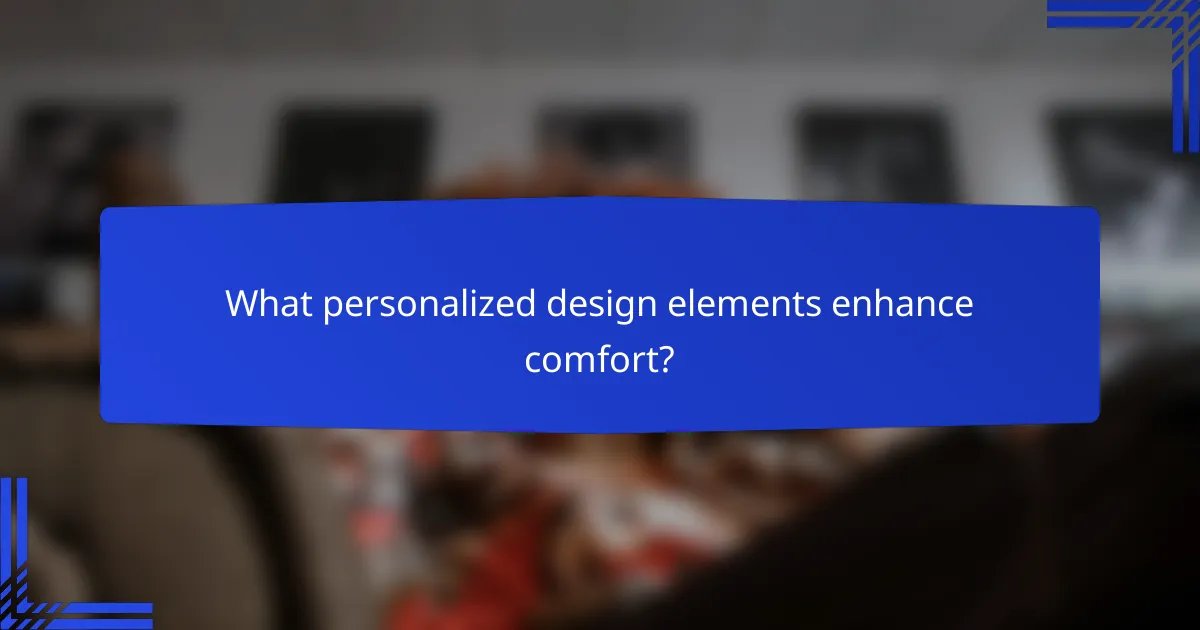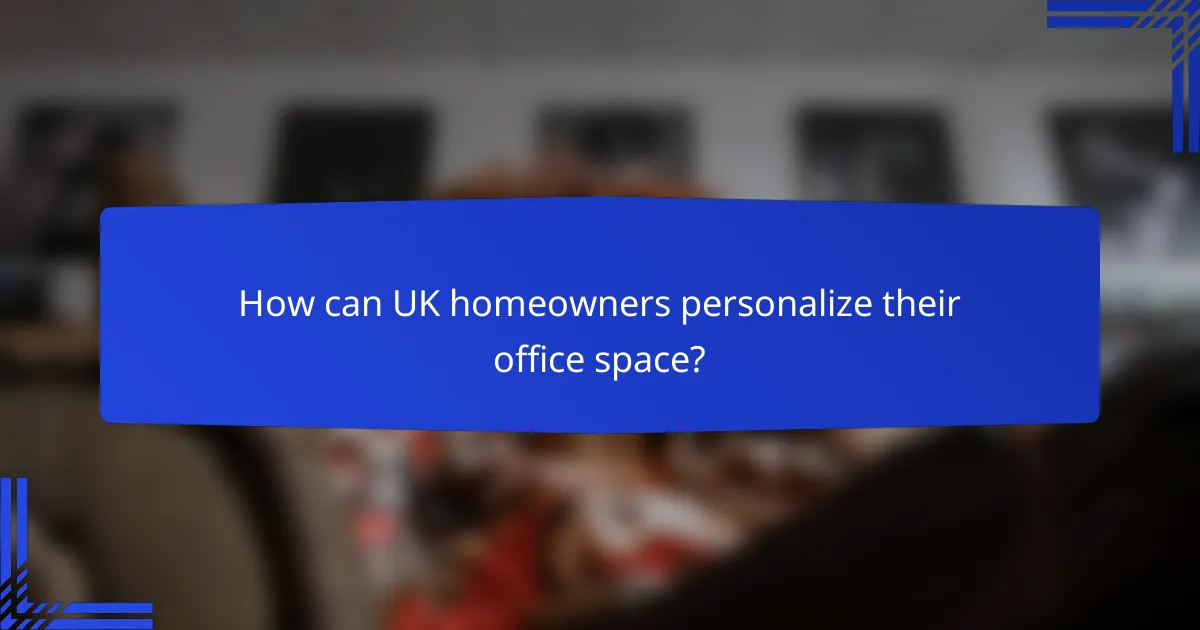Creating a well-designed home office can significantly boost productivity by establishing a dedicated workspace that minimizes distractions and enhances comfort. Incorporating ergonomic furniture, tailored decor, and effective lighting not only fosters efficiency but also allows for a personalized environment that reflects individual style and preferences.

How can a home office boost productivity in the UK?
A well-designed home office can significantly enhance productivity by creating a dedicated workspace that minimizes distractions and maximizes comfort. Key elements such as ergonomic furniture, appropriate lighting, and effective noise reduction contribute to a more efficient working environment.
Ergonomic furniture benefits
Investing in ergonomic furniture is crucial for maintaining comfort during long working hours. Chairs that support the lower back and desks that allow for proper posture can reduce fatigue and discomfort, leading to increased focus and productivity.
Consider adjustable desks that enable both sitting and standing positions, as this flexibility can help prevent stiffness and promote better circulation. Aim for a chair that provides lumbar support and is adjustable to fit your body type.
Optimized lighting solutions
Proper lighting is essential for reducing eye strain and enhancing concentration. Natural light is ideal, so position your desk near windows when possible. If natural light is limited, opt for full-spectrum LED bulbs that mimic daylight and reduce fatigue.
Incorporate task lighting, such as desk lamps, to provide focused illumination on work areas. Avoid harsh overhead lights, which can create glare and discomfort.
Noise reduction techniques
Minimizing noise distractions is vital for maintaining productivity in a home office. Consider soundproofing options like acoustic panels or heavy curtains to absorb sound and reduce echo. These can help create a quieter environment conducive to concentration.
Using noise-cancelling headphones can also be effective, especially if you work in a bustling household. Alternatively, soft background music or white noise machines can mask disruptive sounds and improve focus.

What personalized design elements enhance comfort?
Personalized design elements that enhance comfort in a home office include adjustable furniture, tailored decor, and ergonomic accessories. These features not only improve physical comfort but also create a workspace that reflects individual style and preferences.
Customizable desk setups
Customizable desk setups allow you to adjust the height and layout of your workspace to suit your needs. Consider using sit-stand desks that can be easily modified for sitting or standing positions, promoting better posture and reducing fatigue. Look for desks with cable management systems to keep your workspace tidy.
In addition, incorporating modular components like shelves or drawer units can help organize your tools and materials efficiently. Aim for a desk surface that is spacious enough to accommodate your computer, documents, and any other essentials without feeling cramped.
Personalized decor choices
Personalized decor choices can significantly impact your comfort and productivity. Select colors and artwork that inspire you and create a positive atmosphere. Soft lighting, such as desk lamps with adjustable brightness, can enhance focus while reducing eye strain.
Incorporating plants or personal items, like family photos, can make your office feel more inviting and less sterile. Choose decor that resonates with your personality, but avoid clutter to maintain a clear and functional workspace.

Which home office layouts maximize efficiency?
Home office layouts that maximize efficiency typically balance space utilization, comfort, and accessibility. Key factors include the choice between open and closed layouts, as well as the organization of work zones to enhance productivity.
Open vs. closed layouts
Open layouts promote collaboration and flexibility, allowing for easy movement and interaction. However, they can also lead to distractions, making it crucial to designate quiet zones or use noise-canceling solutions.
Closed layouts provide privacy and minimize interruptions, which can boost focus. Yet, they may feel isolating and limit spontaneous collaboration. Consider your work style and the nature of your tasks when choosing between these layouts.
Zone-based organization
Zone-based organization involves dividing your workspace into distinct areas for different tasks, such as a dedicated area for focused work, meetings, and relaxation. This approach helps streamline activities and reduces the mental load of switching tasks.
To implement this, designate specific zones based on your daily activities. For instance, a quiet corner with minimal distractions can serve as your primary work zone, while a separate area with comfortable seating can be used for brainstorming or breaks. This separation can enhance overall productivity.

What are the key comfort enhancements for home offices?
Key comfort enhancements for home offices include adjustable seating options and effective temperature control systems. These features significantly contribute to a productive and personalized workspace, allowing individuals to work comfortably for extended periods.
Adjustable seating options
Adjustable seating options are crucial for maintaining comfort during long hours of work. Ergonomic chairs that allow for height adjustments, lumbar support, and reclining features can help reduce strain on the back and neck. Look for chairs that offer a range of adjustments to fit your body type and preferences.
When selecting an adjustable chair, consider models with breathable materials and adequate cushioning. A good rule of thumb is to ensure your feet rest flat on the floor and your knees are at a 90-degree angle when seated. Investing in a quality chair can lead to improved posture and productivity.
Temperature control systems
Temperature control systems play a vital role in creating a comfortable home office environment. Options include programmable thermostats, portable heaters, and fans that help maintain a consistent temperature throughout the year. A comfortable temperature typically ranges from 20°C to 22°C (68°F to 72°F) for optimal focus and productivity.
Consider investing in smart thermostats that can be adjusted remotely or set to maintain specific temperatures during work hours. Additionally, using fans or space heaters can provide localized comfort without affecting the entire home. Regular maintenance of HVAC systems ensures efficient operation and comfort year-round.

How does technology influence home office design?
Technology significantly shapes home office design by enhancing functionality, comfort, and efficiency. Smart devices and productivity tools create an environment that supports focused work and personalized preferences.
Smart home integration
Smart home integration involves connecting devices like lighting, thermostats, and security systems to create a cohesive workspace. This technology allows for automated adjustments, such as dimming lights or adjusting temperature, which can enhance comfort and productivity.
Consider using smart speakers or hubs to control your office environment with voice commands. For instance, setting up routines can streamline your workday, such as turning on lights and adjusting the thermostat when you start working.
Productivity apps and tools
Productivity apps and tools are essential for managing tasks, scheduling, and communication in a home office. Applications like project management software and time tracking tools help keep you organized and focused on your goals.
Utilize tools like Trello or Asana for task management and Zoom or Microsoft Teams for communication. These platforms can improve collaboration and efficiency, making it easier to stay on track with projects and deadlines.

What are the best practices for creating a distraction-free workspace?
Creating a distraction-free workspace involves organizing your environment and managing your time effectively. By implementing specific strategies, you can enhance focus and productivity while working from home.
Decluttering strategies
Decluttering is essential for maintaining a distraction-free workspace. Start by removing unnecessary items from your desk and surrounding area. Aim to keep only the essentials, such as your computer, notepad, and a few personal items that inspire you.
Consider using storage solutions like shelves, drawers, or organizers to keep your workspace tidy. Regularly assess your space and eliminate items that no longer serve a purpose. A clean environment can significantly reduce distractions and improve your concentration.
Effective time management techniques
Effective time management is crucial for minimizing distractions and maximizing productivity. Techniques such as the Pomodoro Technique, where you work for 25 minutes followed by a 5-minute break, can help maintain focus. This approach encourages sustained attention while allowing for brief periods of rest.
Additionally, prioritize your tasks using methods like the Eisenhower Matrix, which categorizes tasks based on urgency and importance. By focusing on high-priority items first, you can reduce the feeling of being overwhelmed and stay on track throughout your workday.

How can UK homeowners personalize their office space?
UK homeowners can personalize their office space by incorporating elements that reflect their style and enhance productivity. This includes selecting furniture, colors, and accessories that create a comfortable and motivating environment.
Choosing the Right Furniture
Selecting the right furniture is crucial for a personalized office. Consider ergonomic chairs and desks that suit your height and work style. Adjustable desks, for instance, allow you to alternate between sitting and standing, promoting better posture and comfort.
Additionally, think about storage solutions that fit your needs. Shelving units or filing cabinets can help keep your workspace organized, while decorative elements like plants or artwork can add a personal touch.
Color Schemes and Decor
The color scheme of your office can significantly impact your mood and productivity. Soft, neutral tones can create a calming atmosphere, while brighter colors like yellow or green can stimulate creativity. Choose colors that resonate with you and align with the work you do.
Incorporate decor that inspires you, such as motivational quotes or personal photographs. These elements can make the space feel more inviting and tailored to your personality.
Lighting Considerations
Good lighting is essential for a productive home office. Natural light is ideal, so position your desk near a window if possible. If natural light is limited, invest in adjustable LED desk lamps that mimic daylight to reduce eye strain.
Consider using layered lighting, combining ambient, task, and accent lights to create a well-lit environment that suits different tasks and times of day.
Technology Integration
Integrating technology into your office can enhance functionality and personalization. Consider investing in a quality monitor, keyboard, and mouse that fit your work habits. Smart home devices can also help manage lighting and temperature, creating a more comfortable workspace.
Ensure your tech setup is organized, using cable management solutions to keep cords tidy and out of sight. This not only improves aesthetics but also minimizes distractions.
